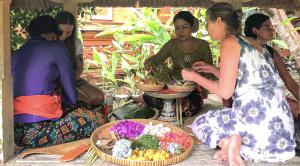Keraton Jimbaran Resort Introduces the Art of Canang Sari to All of the Guests
BADUNG, BALI, INDONESIA, March 2, 2020 /EINPresswire.com/ -- Channelling the authenticity of Balinese heritage, Keraton Jimbaran Resort invites all the guests to experience a deeper level of Balinese culture by partaking Balinese Activity session. The session is held every Thursday at 4:00 p.m. at the resort. During the session, the females will learn on how to make the Canang Sari, and the males will learn on how to make Kelangsah – handwoven coconut leaves which usually used in religious ceremonies. All the activity is under the guidance of local staff at Keraton Jimbaran Resort who not only showing the step by step of creating these delicate arrangements, but also introducing the philosophy behind it which is the sense of gratitude and self-reflection.
One of the fascinating traits about Bali is its rich culture that remains rooted and intact despite the increasing wave of modernisation, therefore mega pieces such prodigious carvings and statues, stones and temples, enthrall parade of religious ceremonies, to the simple piece like Canang Sari (offering to the God) are everywhere to be found.
Anyone that has roamed around the island must have seen those dainty coconut leaves tray filled with rice, colourful flowers, and incense dotted on the each of entrance streets, in front of the houses and shops, as well as on the temples. Despite its petite size, Canang Sari is possessed with a profound meaning – an offering to the Gods as a form of gratitude of the peace given to the world.
The bases of Canang Sari are made of coconut leaf, betel nut and lime which represent the three Hindu deities of supreme divinity in Hinduism, respectively Brahma, Vishnu and Shiva that are epitome for creation, perseverance, and unity. Collectively, each different colours of flowers placed to specific direction symbolises a Hindu God. White flowers that point to the east are for Iswara, the God of Nature, red flowers that point to the south are offered to the Brahma, symbolising the power of creation, yellow flowers that point to the west are for Mahadeva, and the blue or green flowers are faced to the northern direction for the God Vishnu, symbolising as a protection.
In addition to the symbolic coverage that the offering bears, the offering goes through lengthy hand-made process; women craft the basket, assembly the material, place them in specific meaningful directions, sprinkle with holy water, and finished with a burning incense. As the incense catches fire and smokes start to linger creating a unique aroma, the fusion of earth, fire, water and air is now complete. While a little prayer is spoken softly, the smokes carry the essences of the offerings up to the Gods. This serves its purposes of gratitude and sacrifices by the Hindu Balinese, and, if you see a small amount of money and food such as candies or cookies placed on the Canang Sari, this is symbolised as to give back what one has received.

One of the fascinating traits about Bali is its rich culture that remains rooted and intact despite the increasing wave of modernisation, therefore mega pieces such prodigious carvings and statues, stones and temples, enthrall parade of religious ceremonies, to the simple piece like Canang Sari (offering to the God) are everywhere to be found.
Anyone that has roamed around the island must have seen those dainty coconut leaves tray filled with rice, colourful flowers, and incense dotted on the each of entrance streets, in front of the houses and shops, as well as on the temples. Despite its petite size, Canang Sari is possessed with a profound meaning – an offering to the Gods as a form of gratitude of the peace given to the world.
The bases of Canang Sari are made of coconut leaf, betel nut and lime which represent the three Hindu deities of supreme divinity in Hinduism, respectively Brahma, Vishnu and Shiva that are epitome for creation, perseverance, and unity. Collectively, each different colours of flowers placed to specific direction symbolises a Hindu God. White flowers that point to the east are for Iswara, the God of Nature, red flowers that point to the south are offered to the Brahma, symbolising the power of creation, yellow flowers that point to the west are for Mahadeva, and the blue or green flowers are faced to the northern direction for the God Vishnu, symbolising as a protection.
In addition to the symbolic coverage that the offering bears, the offering goes through lengthy hand-made process; women craft the basket, assembly the material, place them in specific meaningful directions, sprinkle with holy water, and finished with a burning incense. As the incense catches fire and smokes start to linger creating a unique aroma, the fusion of earth, fire, water and air is now complete. While a little prayer is spoken softly, the smokes carry the essences of the offerings up to the Gods. This serves its purposes of gratitude and sacrifices by the Hindu Balinese, and, if you see a small amount of money and food such as candies or cookies placed on the Canang Sari, this is symbolised as to give back what one has received.
Yohana Indri Wantania
Keraton Jimbaran Resort
+62 8990433141
email us here
Visit us on social media:
Facebook


